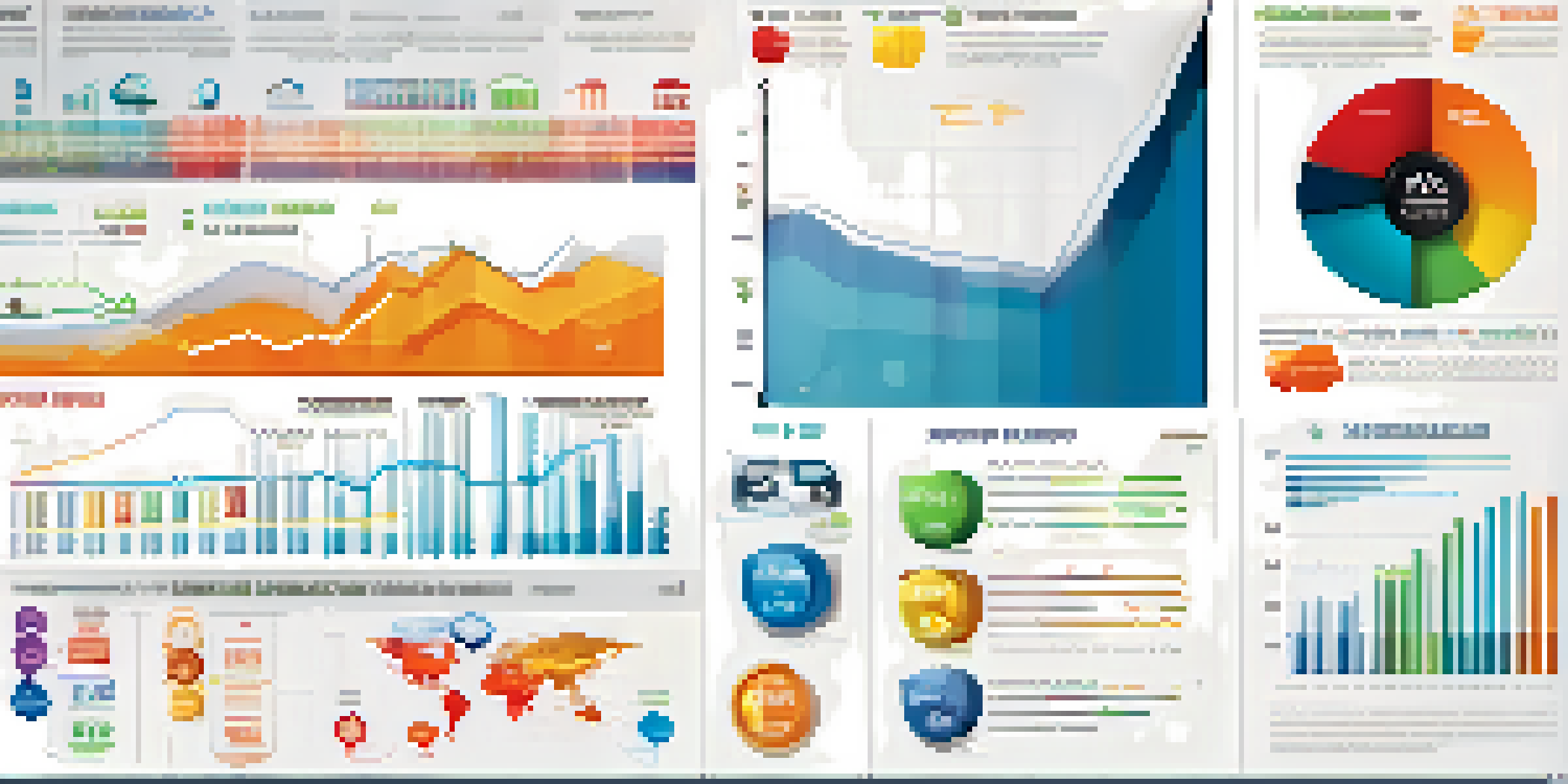How Economic Indicators Influence Financial Risk Assessment

Understanding Economic Indicators and Their Importance
Economic indicators are statistics that provide insights into the health of an economy. They can range from employment rates to inflation measurements, each offering a piece of the larger economic puzzle. By analyzing these indicators, businesses and investors can gauge potential risks and opportunities in the market.
In investing, what is comfortable is rarely profitable.
For example, a rising unemployment rate might signal economic downturns, prompting investors to reassess their portfolios. Conversely, an increase in consumer spending could indicate a robust economy, encouraging investment in new ventures. This dynamic nature of economic indicators makes them vital tools for financial decision-making.
Understanding these indicators helps stakeholders make informed choices that can mitigate financial risks. By keeping an eye on these metrics, organizations can adapt quickly to changing economic landscapes, ensuring better risk management practices.
The Role of GDP in Financial Risk Assessment
Gross Domestic Product (GDP) is one of the most widely recognized economic indicators, representing the total value of goods and services produced in a country. A growing GDP often correlates with a healthy economy, while a declining GDP can signal potential financial instability. Investors closely monitor GDP growth rates to inform their risk assessments.

For instance, if a country’s GDP is on a downward trend, it may prompt investors to reconsider their positions in that market. This caution is essential, as a shrinking economy can lead to reduced corporate profits and increased default risks. Therefore, GDP serves as a critical benchmark in evaluating financial risks.
Economic Indicators Guide Decisions
Understanding economic indicators like GDP and inflation helps businesses and investors make informed financial choices.
By analyzing GDP trends, companies can make strategic decisions on investments, expansions, or budget cuts. This proactive approach helps organizations navigate uncertain economic waters, ultimately leading to a more resilient financial strategy.
Inflation Rates and Their Impact on Financial Decisions
Inflation refers to the rate at which the general level of prices for goods and services rises, eroding purchasing power. High inflation can lead to uncertainty in the financial markets, affecting everything from consumer spending to investment returns. Consequently, understanding inflation rates is crucial for accurate financial risk assessments.
The stock market is filled with individuals who know the price of everything, but the value of nothing.
For example, if inflation is high, central banks might raise interest rates to stabilize the economy. This can increase borrowing costs for businesses and consumers alike, leading to reduced spending and investment. Investors need to factor in these changes when evaluating potential risks and returns.
Thus, monitoring inflation trends allows stakeholders to anticipate shifts in market conditions. By adjusting their financial strategies accordingly, companies can safeguard their investments against inflation-related risks.
Unemployment Rates as a Key Economic Indicator
Unemployment rates indicate the percentage of the labor force that is unemployed but actively seeking employment. High unemployment can signal economic distress, influencing consumer confidence and spending habits. As such, understanding unemployment trends is critical for assessing financial risks.
When unemployment rises, disposable income typically decreases, leading to lower consumer spending. This can adversely affect businesses, particularly those in retail and services, increasing the risk of poor financial performance. Investors often view rising unemployment as a red flag for potential market volatility.
Interconnected Indicators Affect Risks
The interplay between economic indicators, such as unemployment and consumer confidence, is crucial for comprehensive risk assessment.
By keeping an eye on unemployment figures, companies can better anticipate changes in consumer behavior and adjust their strategies accordingly. This proactive approach helps mitigate the risks associated with economic downturns.
Consumer Confidence Index and Market Stability
The Consumer Confidence Index (CCI) measures how optimistic or pessimistic consumers are regarding their expected financial situation. A high CCI typically correlates with increased consumer spending, which is crucial for economic growth. Financial analysts use the CCI to gauge market stability and potential risks.
When consumer confidence is low, spending tends to decline, which can lead to reduced business revenues and increased financial risks. Investors must consider CCI trends when making decisions, as a drop in consumer confidence can foreshadow economic downturns.
By tracking the CCI, businesses can gain insights into consumer behavior, allowing them to adjust marketing strategies or product offerings. This adaptability is essential for sustaining growth during uncertain times.
Interest Rates and Their Influence on Financial Risk
Interest rates, set by central banks, play a pivotal role in shaping financial markets. They affect borrowing costs, consumer spending, and investment decisions. Understanding interest rate trends is essential for assessing financial risks, as high rates can deter borrowing and spending.
For instance, when interest rates rise, individuals and businesses may delay major purchases or investments, leading to slower economic growth. Investors need to be cautious, as these shifts can impact market performance and increase financial risks.
Proactive Strategies Enhance Stability
By leveraging economic data, organizations can adapt their strategies to mitigate risks and foster long-term growth.
By monitoring interest rate changes, organizations can make informed decisions about financing and investment strategies. This awareness helps them navigate the economic landscape more effectively and reduce potential risks.
The Interconnectedness of Economic Indicators
Economic indicators do not operate in isolation; they often influence one another in complex ways. For example, rising unemployment can lead to lower consumer spending, which can then impact GDP growth. This interconnectedness makes it essential for financial professionals to consider multiple indicators when assessing risks.
Understanding how these indicators interact can provide a more comprehensive view of the economic environment. For instance, if inflation is high, it may prompt central banks to raise interest rates, impacting consumer confidence and spending habits. This ripple effect underscores the importance of holistic analysis in risk assessment.

By recognizing these connections, businesses can develop more robust financial strategies that account for various economic scenarios. This proactive approach can help mitigate risks and enhance overall financial stability.
Conclusion: Leveraging Economic Indicators for Smarter Risk Management
In conclusion, economic indicators are vital tools for assessing financial risks. By understanding how metrics like GDP, inflation, and unemployment affect market conditions, businesses can make informed decisions. This proactive approach not only helps in minimizing risks but also positions organizations for growth.
Investors and financial professionals must continuously monitor these indicators to stay ahead in an ever-changing economic landscape. Adapting strategies based on current economic data can lead to more resilient financial outcomes.
Ultimately, leveraging economic indicators for risk assessment empowers organizations to navigate uncertainties with confidence. This informed decision-making can pave the way for sustainable success in the financial realm.